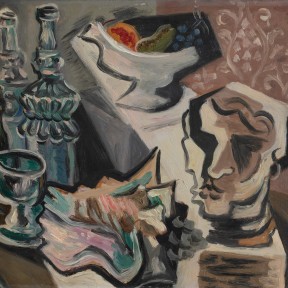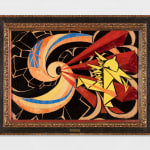-
Biography
Giacomo Balla (Turin, Italy 1871 – Rome, Italy 1958)
He studied at the Regia Albertina Academy under Cesare Lombroso, influenced by the combination of pointillism and social realism of Pellizza da Volpedo. In 1895, he moved to Rome.
The artistic environment in Rome was fascinated by the pointillist technique, and Balla soon became a point of reference for young artists such as Boccioni, Sironi and Severini.
His pointillist broken brushstrokes led him to an increasingly vibrant and dynamic theme of Futurism, to which Balla fully subscribes by signing the Manifesto of Futurist Painters and Futurist Painting in 1910, further exploring the depiction of motionless surfaces and continuous movement.
Transparency and light overlapping tones that diminish the weight of what is moving lead Balla towards a more marked vigour of geometric shapes which alternate between fundamental and complementary colours, functional to expressing the optical function of the dynamism of kinetic and programmed painting.
Two of his most well-known masterpieces date from this period: Bambina che corre sul balcone and Dinamismo di un cane al guinzaglio.
His life is very lively. In 1913, he sold his pointillist works with the text “Balla è morto. Qui si vendono all’asta le sue opere” (Balla is dead. His works are auctioned here) a provocation to signal the beginning of a new pictorial research, beyond the conventional approach.
In 1915, an activist like all other Futurists, Balla was arrested with Marinetti and other artists while demonstrating against Italy’s involvement in the First World War. In the same year, he signed the Manifesto of the Futurist reconstruction of the Universe with Depero.
Upon the death of Boccioni (1916), to whom he dedicated the artwork Pugno di Boccioni, Balla became the undisputed leader of the movement. To mark this, he began to sign his artworks as “Futurballa”. In 1917, he designed the stage set for the ballet Feu d’artifice with music by Igor Stravinsky at the Costanzi Theatre in Rome (known today as the Opera House).
He joined the fascist regime.
The Manifesto of Futurist Aeropainting in 1929 was the last commitment of Balla to Futurism and, in the 1930s, Balla returned to figurative realism.
After taking part in the Venice Biennale and the first edition of the Rome Quadriennale, in 1934, he participated in the Modern Works of Art exhibition organised at the MoMA in New York, marking the beginning of his international success.
The Second World War brought a period of introspection for Balla, who dedicated most of his time to his family.
In 1950, the Venice Biennale paid homage to those who signed the first Futurist Manifesto. His works are now exhibited and known internationally and included in important collections. In 1956, he received a Gold Medal from the President of the Republic for being one of the most prominent artists of the twentieth century.
He died in Rome, March 1958.
Copyright the artist. Photo UniCredit Group (Sebastiano Pellion di Persano)
-
Works
Giacomo Balla Italian, 1871-1958
La Guerra, 1916Oil and coloured paper collage applied on spolvero pad / Olio e collage di carta colorata applicata su carta da spolvero / Collage aus Öl und farbigem Papier, aufgetragen auf Spolvero-Pad26 x 33 1/8 in
66 x 84 cmUniCredit S.p.A.© Giacomo Balla, by SIAE 2023Photo: UniCredit Group (Sebastiano Pellion di Persano)








